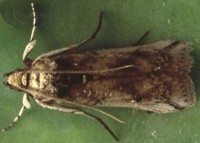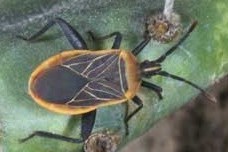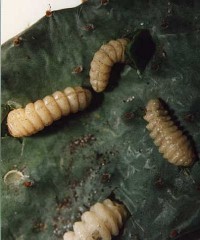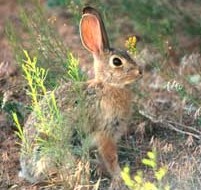 The most widely known insect enemy of pricklypear is the cactus moth, Cactoblastis cactorum (Lepidoptera: Pyralidae), which was credited with the successful biological control of pricklypear in Australia. The cactus moth was introduced from Argentina into Australia in 1925, where it was free from its own natural parasites and predators. Cactus moth larvae consume the pulpy tissues within the pads, which are then rapidly invaded by soft rot bacteria and fungi. This results in a rapid and virtually complete collapse of the plant (Mann 1970). The moths avoid nutritionally deficient pricklypear plants. Fertilization was necessary to get successful control of pricklypear with the cactus moths on soils with low fertility levels. This insect does not occur in North America and has not been introduced because of the conflict of interest between those who value pricklypear for various reasons and those who primarily regard it as a pest weed.
The most widely known insect enemy of pricklypear is the cactus moth, Cactoblastis cactorum (Lepidoptera: Pyralidae), which was credited with the successful biological control of pricklypear in Australia. The cactus moth was introduced from Argentina into Australia in 1925, where it was free from its own natural parasites and predators. Cactus moth larvae consume the pulpy tissues within the pads, which are then rapidly invaded by soft rot bacteria and fungi. This results in a rapid and virtually complete collapse of the plant (Mann 1970). The moths avoid nutritionally deficient pricklypear plants. Fertilization was necessary to get successful control of pricklypear with the cactus moths on soils with low fertility levels. This insect does not occur in North America and has not been introduced because of the conflict of interest between those who value pricklypear for various reasons and those who primarily regard it as a pest weed.Other arthropods that were introduced into Australia prior to 1925, and which were providing partial suppression of pricklypear, included: the spider mite Tetranychus opuntiae (Acari: Tetranychidae); the cactus bugs Chelinidea tabulata and C. vittiger (Hemiptera: Coreidae); and the cochineals Dactylopius opuntiae, D. tomentosus, and D. austrinus (Homoptera: Dactylopiidae) (Dodd 1940). The cactus moth and/or one of the cochineal insects have been utilized for biological control of various pricklypear species in numerous countries, with varying degrees of success.
Insects recognized as pests of pricklypear in the United States which occupy niches similar to that of Cactoblastis cactorum include the banded cactus borers, Olycella junctolineela and Ol. subumbrella, and the blue cactus borers, Melitara dentata, M. prodeniales, and M. fernaldialis. Two cochineal insects, Dactylopius confusus and D. opuntiae, are indiginous to the United States and attack pricklypear.
 Plains prickly-pear is susceptible to damage by several insects, including a moth (Melitara dentata), the blue cactus borer (Olycella subumbrella), and the cactus bug (Chelinidea vittiger) [80,102]. These insects are favored by moist conditions and can be an effective means of natural control during wet periods [17]. Both the cactus bug and the blue cactus borer prefer burned cactus pads (stems) to unburned pads [58,80]. This preference may help to increase prickly-pear mortality after prescribed fire.
Plains prickly-pear is susceptible to damage by several insects, including a moth (Melitara dentata), the blue cactus borer (Olycella subumbrella), and the cactus bug (Chelinidea vittiger) [80,102]. These insects are favored by moist conditions and can be an effective means of natural control during wet periods [17]. Both the cactus bug and the blue cactus borer prefer burned cactus pads (stems) to unburned pads [58,80]. This preference may help to increase prickly-pear mortality after prescribed fire.The cochineals are small, red-bodied insects similar to mealybugs in appearance that suck the juices from pricklypear pads. After the female cochineal nymph settles and inserts her proboscis into a pricklypear pad, she covers her body with a floculent mass of white, waxy plates that resemble cotton, and remains stationary for life. Heavy and prolonged infestations result in chlorosis, pad abscission, necrosis, and death of the plant parts affected.
Cactus bugs (Chelinidea spp.) resemble squash bugs in appearance. They also suck juices from pricklypear pads and fruits. Their feeding punctures cause circular, chlorotic lesions and the pads turn yellow, but their impact is most often negligible. Coreids in the genus Narnia suck juices primarily from the fruits, but they rarely have a major impact on seed production.
 Adults of long-horned beetles in the genus Moneilema chew on edges of new pricklypear pads, sometimes causing pad abscission. Their larvae bore into the older pads and basal stems, making wide galleries that become blackened and that are accompanied by the exudation of a very noticeable black sap from the pads. Several weevils and flies also attack pricklypear. The red spider mite Tetranychus opuntiae attacks Lindheimer pricklypear. Its feeding causes a greyish layer of corky epidermis, initially around the areoles, but completely covering the pad surfaces when infestations are heavy.
Adults of long-horned beetles in the genus Moneilema chew on edges of new pricklypear pads, sometimes causing pad abscission. Their larvae bore into the older pads and basal stems, making wide galleries that become blackened and that are accompanied by the exudation of a very noticeable black sap from the pads. Several weevils and flies also attack pricklypear. The red spider mite Tetranychus opuntiae attacks Lindheimer pricklypear. Its feeding causes a greyish layer of corky epidermis, initially around the areoles, but completely covering the pad surfaces when infestations are heavy.Populations of the native insect enemies of pricklypear in Texas rarely have a significant impact on pricklypear populations, except in isolated instances and for brief periods, because their abundance is regulated by their own complex of parasites and predators. Some of the native insects increase in abundance for a year or two following grassland fires and appear to augment the direct effects of fire in suppressing or killing pricklypear. However, the duration and extent of the fire-insect interaction is rarely sufficient to totally control pricklypear. Some insect enemies of pricklypear, including the blue cactus borer, cactus bugs, and cochineal insects, are reported to increase in abundance in the Central Great Plains during periods of warm moist weather which result in increased standing crops of grasses around pricklypear plants (Cook 1942, Bugbee and Reigel 1945).
 Plains prickly-pear is an important seasonal food of the black-tailed prairie dog, composing up to 58% of its winter diet. Pronghorn rely on plains prickly-pear, notably after fire. Fires burn the spines off the plants, providing a source of preferred forage. Other animals reported to eat plains prickly-pear include: northern pocket gopher, bushy-tailed woodrat, Nuttall cottontail, black-tailed jackrabbit, white-tailed jackrabbit, desert cottontail, least chipmunk, bison, white-tailed deer, collared peccary, northern bobwhite.
Plains prickly-pear is an important seasonal food of the black-tailed prairie dog, composing up to 58% of its winter diet. Pronghorn rely on plains prickly-pear, notably after fire. Fires burn the spines off the plants, providing a source of preferred forage. Other animals reported to eat plains prickly-pear include: northern pocket gopher, bushy-tailed woodrat, Nuttall cottontail, black-tailed jackrabbit, white-tailed jackrabbit, desert cottontail, least chipmunk, bison, white-tailed deer, collared peccary, northern bobwhite.Prickly-pear in the genus Opuntia have been utilized as a forage substitute for grazing livestock in Texas and Mexico for at least a century. It is highly variable in nutrient content, depending on species or variety, age, and plant part. Most research indicates that Opuntia prickly-pear are low in protein and phosphorus but high in energy, water, fiber, and ash.
Many species of Opuntia prickly-pear are used as food by humans. Native Americans ate plains prickly-pear fruit raw, dried, or cooked. Fruit was piled on the ground and stirred with branches, rolled or singed with hot coals to remove spines, then split and dried in the sun. The flesh of plains prickly-pear was used as a binding agent in garment and weapon making. Ripe fruits were used for dye.
Pricklypear Ecology
Opuntia polyacantha: Introductory
Genus Opuntia (incl. Cylindropuntia, Grusonia, and Corynopuntia)